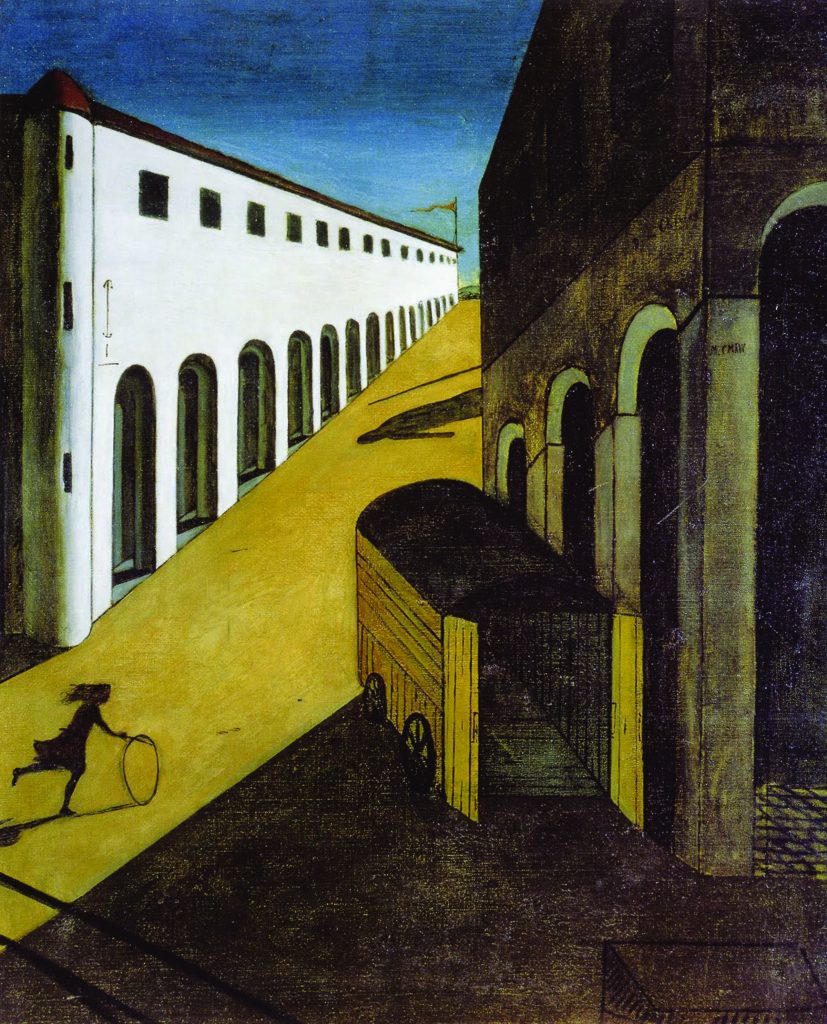Mystery and Melancholy of a street by Giorgio De Chirico
De Chirico’s haunting classical architecture, with its stark arched openings, was inspired by his mnemonic recollections of the scenography of the Northern Italian city of Turin.
Giorgio de Chirico, the Italian-Greek born artist, was the founder – together with Carlo Carrà – of the Pittura Metafisica movement in the second decade of the 20th century. His best and most influential work is that produced in the decade between 1909 and 1919 in what he termed his ‘metaphysical period’ before he reverted to a more classical Baroque style.
The subjects, during his metaphysical period, focused on brooding, foreboding piazzas haunted by enigmatic, elongated shadows and, at times, inhabited by strange mannequin figurines. I have always been fascinated by de Chirico’s work of this period, with a particular interest in his 1913 body of works including The Soothsayer’s Reward, The Big Tower, The Red Tower and The Tower – exceptional canvasses with an architectural, dreamlike and mysterious ambiance.
Because of their ominous sinister cityscapes they were, in a way, prognostic and clairvoyant metaphors for the emptiness of times then still to come. My favourite de Chirico metaphysical painting is his 1914 mystical painting Mystery and Melancholy of a Street – again, a spectral depiction of an Italian-Mediterranean piazza. In the painting, the sun-washed square is inhabited by two figures, one animate and the other inanimate and out of the picture; the former is a young girl playing with a hoop, while the latter is a statue whose presence is only made manifest through its elongated enigmatic shadow.

De Chirico’s painting harbours two incompatible perspective vanishing points which further contribute to the ambivalent atmosphere of the work. However, it is the artist’s eclipse-like quality of light that gives the painting its malevolent aura. There is no doubt that this is an unsettling and disconcerting canvas with its limbo-like mise-en-scène. De Chirico’s haunting classical architecture, with its stark arched openings, was inspired by his mnemonic recollections of the scenography of the Northern Italian city of Turin. In his subsequent memoirs, he himself referred to the unsettling mood of the town which he found particularly fascinating.
Another influence that is evident in de Chirico’s early metaphysical paintings is his homage to the 19th century writings of Nietzsche. However, it is the strange juxtaposition of illusion and reality that renders his works baffling, unsettling and de-railing. Particularly in the Mystery and Melancholy of a Street, one senses an anticipatory feeling as if something menacing and sinister is about to happen.
I remember an excellent Italo Calvino article in a 1983 FMR issue entitled ‘Viaggio nelle Citta di de Chirico’, an intriguing verbal visual interaction between a mysterious and mystical writer and a baffling visual artist. Calvino’s disorientating narrative unites the two hybrid modes of expression in a carefully crafted verbal medium, rich in visual and philosophical imagery.
Both Calvino and de Chirico were imaginative creative artists, working in their own distinctive idioms, and the combination in Calvino’s text is both poetic and stimulating. Calvino is so overcome by de Chirico’s portrayal of the juxtaposition of the usual and the unusual that he feels completely absorbed and undertaken by the artist’s delineated cities. “Ever since I entered this city, the city has entered into me. There is no room inside me for anything else.” Meditating on images of the painting Mystery and Melancholy of a Street (the original is in a private collection) always conjures up a sensation of tantalising intrigue. De Chirico said that “one must picture everything as an enigma” and that “the ghostly and metaphysical may only be seen by rare individuals in moments of clairvoyance and metaphysical abstraction”. This particular painting, and other works by de Chirico of the same period, has consistently served as powerful inspirational sources for many of my own architectural works, as these paintings were also perhaps predecessors for much of the work of the Italian Rationalist Movement (La Tendenza), of such architects as Giorgio Grassi, Aldo Rossi and Carlo Aymonino.
It is to de Chirico’s credit, as a metaphysical artist, that his influences are still evident almost a whole century later. The painting Mystery and Melancholy of a Street remains one of my favourite and most influential works of the 20th century art scene.








